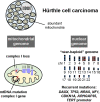Genetics, Diagnosis, and Management of Hürthle Cell Thyroid Neoplasms
- PMID: 34177816
- PMCID: PMC8223676
- DOI: 10.3389/fendo.2021.696386
Genetics, Diagnosis, and Management of Hürthle Cell Thyroid Neoplasms
Abstract
Hürthle cell lesions have been a diagnostic conundrum in pathology since they were first recognized over a century ago. Controversy as to the name of the cell, the origin of the cell, and even which cells in particular may be designated as such still challenge pathologists and confound those treating patients with a diagnosis of "Hürthle cell" anything within the diagnosis, especially if that anything is a sizable mass lesion. The diagnosis of Hürthle cell adenoma (HCA) or Hürthle cell carcinoma (HCC) has typically relied on a judgement call by pathologists as to the presence or absence of capsular and/or vascular invasion of the adjacent thyroid parenchyma, easy to note in widely invasive disease and a somewhat subjective diagnosis for minimally invasive or borderline invasive disease. Diagnostic specificity, which has incorporated a sharp increase in molecular genetic studies of thyroid tumor subtypes and the integration of molecular testing into preoperative management protocols, continues to be challenged by Hürthle cell neoplasia. Here, we provide the improving yet still murky state of what is known about Hürthle cell tumor genetics, clinical management, and based upon what we are learning about the genetics of other thyroid tumors, how to manage expectations, by pathologists, clinicians, and patients, for more actionable, precise classifications of Hürthle cell tumors of the thyroid.
Keywords: Hürthle cell; Hürthle cell carcinoma; oncocytic; thyroid; thyroid cancer.
Copyright © 2021 McFadden and Sadow.
Conflict of interest statement
The authors declare that the research was conducted in the absence of any commercial or financial relationships that could be construed as a potential conflict of interest.
Figures




Similar articles
-
Does Hurthle cell lesion/neoplasm predict malignancy more than follicular lesion/neoplasm on thyroid fine-needle aspiration?Diagn Cytopathol. 2006 May;34(5):330-4. doi: 10.1002/dc.20440. Diagn Cytopathol. 2006. PMID: 16604553
-
Unraveling Hürthle cell lesions of the thyroid using molecular findings.Cancer Cytopathol. 2022 Jun;130(6):405-406. doi: 10.1002/cncy.22567. Epub 2022 Mar 14. Cancer Cytopathol. 2022. PMID: 35285577 No abstract available.
-
Fine-needle aspiration biopsy of Hurthle cell lesions of the thyroid gland: A cytomorphologic study of 139 cases with statistical analysis.Cancer. 2006 Apr 25;108(2):102-9. doi: 10.1002/cncr.21716. Cancer. 2006. PMID: 16453320
-
Cytologic Diagnosis of Oncocytic Neoplasms of the Thyroid Gland: The Importance of the Clinical Scenario.Appl Immunohistochem Mol Morphol. 2019 Nov/Dec;27(10):726-731. doi: 10.1097/PAI.0000000000000713. Appl Immunohistochem Mol Morphol. 2019. PMID: 30358610 Review.
-
Short Review: Genomic Alterations in Hürthle Cell Carcinoma.Thyroid. 2019 Apr;29(4):471-479. doi: 10.1089/thy.2019.0088. Thyroid. 2019. PMID: 30848171 Review.
Cited by
-
Significance of oncocytic features in poorly differentiated thyroid carcinoma - a bi-institutional experience.Virchows Arch. 2023 Mar;482(3):479-491. doi: 10.1007/s00428-022-03422-4. Epub 2022 Nov 8. Virchows Arch. 2023. PMID: 36346459
-
Hürthle Cell Carcinoma: Single Center Analysis and Considerations for Surgical Management Based on the Recent Literature.Front Endocrinol (Lausanne). 2022 Jun 29;13:904986. doi: 10.3389/fendo.2022.904986. eCollection 2022. Front Endocrinol (Lausanne). 2022. PMID: 35846317 Free PMC article.
-
Reprogramming of Cellular Metabolism and Its Therapeutic Applications in Thyroid Cancer.Metabolites. 2022 Dec 3;12(12):1214. doi: 10.3390/metabo12121214. Metabolites. 2022. PMID: 36557253 Free PMC article. Review.
-
Estrogen-related receptor alpha promotes thyroid tumor cell survival via a tumor subtype-specific regulation of target gene networks.Oncogene. 2024 Jul;43(31):2431-2446. doi: 10.1038/s41388-024-03078-1. Epub 2024 Jun 27. Oncogene. 2024. PMID: 38937602 Free PMC article.
-
Mitochondrial-Encoded Complex I Impairment Induces a Targetable Dependency on Aerobic Fermentation in Hürthle Cell Carcinoma of the Thyroid.Cancer Discov. 2023 Aug 4;13(8):1884-1903. doi: 10.1158/2159-8290.CD-22-0982. Cancer Discov. 2023. PMID: 37262072 Free PMC article.
References
-
- Askanazy M. Pathologisch-Anatomische Beiträge Zur Kenntniss Des Morbus Basedowii, Insbesondere Uber Die Dabei Auftretende Muskelerkrankkung. Dtsch Arch Klin Med (1898) 61:118–86.
-
- LiVolsi V, Baloch ZW, Sobrinho Simoes M, Tallini G. Hurthle (Oncocytic) Cell Tumours. Lyon: International Agency for Research on Cancer; (2017).
-
- Chan JKC, Hirokawa M, Evans H, Williams ED, Osamura Y, Cady B, et al. . Follicular Adenoma. Lyon: International Agency for Research on Cancer; (2004).
-
- Sobrinho Simoes M, Asa SL, Kroll TG, Nikiforov Y, DeLellis R, Farid P, et al. . Follicular Carcinoma. Lyon: International Agency for Research on Cancer; (2004).
Publication types
MeSH terms
Supplementary concepts
Grants and funding
LinkOut - more resources
Full Text Sources
Medical
Miscellaneous

